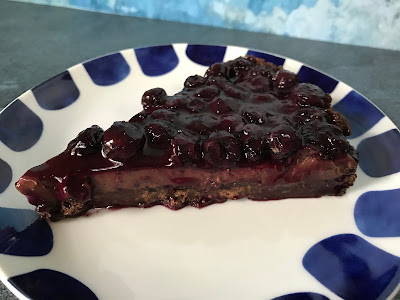I recently picked up my copy of
Gluten-Free Girl and the Chef and realized that I still had two dessert recipes I had flagged and not tried yet. The situation was easy to rectify: I made the peanut butter brownies, which were fine, and the
carrot cake with ginger frosting, which was great!
I think I had put off this recipe because the list of ingredients is long and, therefore, intimidating, but once I decided to just do it, it was pretty painless. I happened to have all the dry ingredients in my pantry, including all the rice flours. Note however that I couldn’t find carrot juice in the store that day, so I pulled out my juicer (which I seldom use at this point, but am reluctant to get rid off because, as you can see, it *was* useful!) and 2 pounds of carrots and made my own. I’ll totally understand if you wait until you can buy some, though! I measured all the flours by weight and think that you could replace the flours and gums with all-purpose wheat flour if gluten is not an issue for you, though I haven’t tried.
Also, I halved the frosting because I’m assuming that “enough” here means enough to cover the top of the cake and leave the sides bare, as I did. I found the frosting too soft to cover the sides of the cake properly anyway, as is often the case with cream cheese frosting as opposed to a buttercream. The amounts below are mine, but feel free to double them if you want to try your luck.
For the cake
2 cups fresh carrot juice
⅔ cup (75 g/2.6 oz.) almond flour
½ cup (60 g/2 oz.) tapioca flour
¼ cup (30 g/1 oz.) sweet rice flour
¼ cup (30 g/1 oz.) superfine brown rice flour
1 tsp. xanthan gum
¾ tsp. guar gum
¾ tsp. baking powder
1 tsp. salt
1 tsp. ground cinnamon
½ tsp. ground nutmeg
½ tsp. ground ginger
¼ tsp. ground cloves
1 cup (2 sticks) lactose-free butter, at room temperature
½ cup granulated sugar
½ cup dark brown sugar
4 eggs + 2 separated eggs, divided
grated zest of 1 orange
1 tsp. vanilla extract
1 cup peeled and grated carrots
⅓ cup chopped walnuts (optional; the Engineer and I prefer our cake without them)
⅓ cup golden raisins (optional; our kids vetoed them)
1 pinch cream of tartar
For the frosting
4 oz. lactose-free cream cheese
½ cup (1 stick) lactose-free butter, at room temperature
1 ½ tsp. ground ginger (I used half that)
1 pinch ground cardamom
1 ½ to 2 cups powdered sugar, sifted
For the cake
In a small saucepan over medium heat, bring the carrot juice to a boil, then reduce the heat to low. Slowly reduce the juice, stirring occasionally, until it is reduced to ¼ cup and is darkened in color, about 20 minutes. Remove from heat and set aside to cool.
Preheat the oven to 350 °F. Cut a circle of parchment paper to fit the base of a 9-inch cake pan. Grease both sides of the paper and place it in the pan. Set aside.
Into a large bowl, sift together the almond flour, tapioca flour, sweet rice flour and brown rice flour. Sift in the xanthan gum, guar gum, baking powder, salt, cinnamon, nutmeg, ginger, and cloves. Stir together the flour-and-spice mixture to make sure the ingredients are evenly distributed and set aside.
In the bowl of a stand mixer, or in a large bowl using a hand mixer, beat butter with the white and brown sugars until creamy and fluffy, 3 to 5 minutes. Add the 4 whole eggs and 2 egg yolks, one at a time, until fully incorporated. Beat in the orange zest and vanilla, then the reduced carrot juice.
Slowly add the flour-and-spice mixture to the liquid until combined. Gently stir in the carrots, and walnuts and raisins (if using). The cake batter should be quite thick, but you should still be able to work a rubber spatula through it easily.
In a clean, dry mixing bowl, beat the 2 remaining egg whites with the cream of tartar with the hand mixer until they form stiff peaks. Gently fold the stiff egg whites into the cake batter until they are entirely incorporated.
Pour the batter into the prepared cake pan. Slide the pan into the oven and bake until a knife inserted into the center of the cake comes out clean and the top is golden brown, about 45 minutes. Transfer the pan to a wire rack and set aside for 15 minutes before removing it from the pan. Turn the cake out onto the rack, turn it right side up, and cool completely before frosting it.
For the frosting
In a mixing bowl, beat together the cream cheese, butter, ginger and cardamom with the hand mixer until smooth. Gently beat in 1 ½ cups powdered sugar, then beat in more if you prefer the frosting thicker and sweeter. Spread the frosting on the top of the cake before slicing and serving.



















































